
Regina is the capital city of the Canadian province of Saskatchewan. The city is the second-largest in the province, after Saskatoon, and is a commercial centre for southern Saskatchewan. As of the 2021 census, Regina had a city population of 226,404, and a metropolitan area population of 249,217. It is governed by Regina City Council. The city is surrounded by the Rural Municipality of Sherwood No. 159.
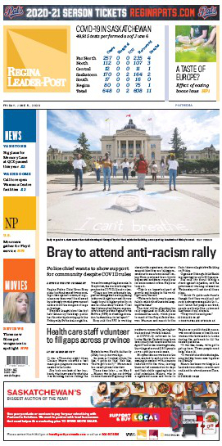
The Regina Leader-Post is the daily newspaper of Regina, Saskatchewan, Canada, and a member of the Postmedia Network.
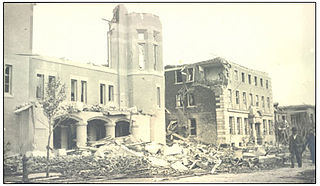
The Regina Cyclone, or Regina tornado of 1912, was a tornado that devastated the city of Regina, Saskatchewan, Canada, on Sunday, June 30, 1912. It remains the deadliest tornado in Canadian history with a total of 28 fatalities and about 300 people injured. At about 4:50 p.m., green funnel clouds formed and touched down south of the city, tearing through the residential area between Wascana Lake and Victoria Avenue, and continuing through the downtown business district, rail yards, warehouse district, and northern residential area.

The history of Regina, Saskatchewan, the capital of the Canadian province of Saskatchewan. Prior to the province's establishment, Regina served as the territorial headquarters of the then-North-West Territories and district headquarters of the territorial district of Assiniboia.

Government House in Regina, Saskatchewan, Canada, is the official office of the lieutenant governor of Saskatchewan. It was first constructed as a residence for the lieutenant governor of the North-West Territories, whose territorial headquarters were in Regina. When the provinces of Saskatchewan and Alberta were created out of the Territories in 1905, Regina became the capital of Saskatchewan and Government House became the official residence of the lieutenant governor of Saskatchewan. It was vacated in 1944 and then returned to official ceremonial use in 1984.
Regina, Saskatchewan has a rich cultural life in music, theatre and dance, amply supported by the substantial fine arts constituency at the University of Regina, which has a large fine arts department including faculties of music and theatre. At various times this has attracted notable artistic talent: Donald M. Kendrick and Joe Fafard have been particular stars.
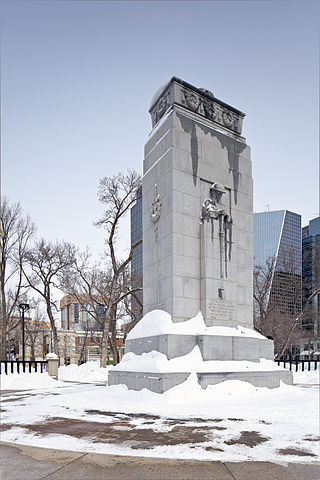
Victoria Park is a public park in the centre of downtown Regina, the capital of the Canadian province of Saskatchewan.
Globe Theatre in Regina, Saskatchewan, Canada was founded in 1966 by Ken and Sue Kramer. It was the first professional educational theatre company in Saskatchewan.

The Conexus Arts Centre, known from 1970 till 2006 as the Saskatchewan Centre of the Arts, is a theatre complex located within Wascana Centre in Regina, Saskatchewan, Canada, which largely replaces former theatres downtown and Darke Hall on the original campus of Regina College, also in Wascana Centre but north of Wascana Lake.

Many historically significant buildings in Regina, Saskatchewan were lost during the period 1945 through approximately 1970 when the urge to "modernize" overtook developers' and city planners' sense of history and heritage. The old warehouse district to the north of the old CPR tracks was Regina's original commercial raison d'être once Lieutenant-Governor Edgar Dewdney had established the site of his considerable landholdings as the Territorial Capital. 1899 to 1919 Washington Park and 3431 Dewdney Ave building as CPR commercial logistics building, expanded connected with significant conversion of shipping of commercial goods from train to truck and cancellation of passenger service on the railway, the Warehouse District immediately adjacent to the train line has ceased to be exclusively industrial in character. Some areas of the Warehouse District have been transformed into a shopping, entertainment and residential precinct.

Nutana is a primarily residential neighbourhood located near the centre of Saskatoon, Saskatchewan, Canada. It includes the business district of Broadway Avenue. It comprises a nearly even mixture of low-density, single detached dwellings and apartment-style multiple unit dwellings. As of 2009, the area is home to 6,261 residents. The neighbourhood is considered a middle to upper-income area, with an average family income of $67,657, an average dwelling value of $206,830 and a home ownership rate of 51.3%. First established in 1883, Nutana was the original settlement of what now makes up the city of Saskatoon.

The Central Business District is one of seven development districts in Saskatoon, Saskatchewan, Canada. The central business district is Ward 6 of a Mayor-Council government represented by councillor Cynthia Block. Formerly called West Saskatoon, this area arose when the steam engines built their pumping stations on the lower west bank of the South Saskatchewan River. Retail enterprises sprang up around the newly created train station and rail yards. The city of Saskatoon's Central Business District has shopping malls and boutiques.

Seven neighbourhoods are of considerable note:
The timeline of Regina history shows the significant events in the history of Regina, Saskatchewan, Canada.

Neil R. Darrach (1850–1926) was a noted Canadian architect from St. Thomas, Ontario. He was architect for over five designated heritage properties in St. Thomas, Ontario and Regina, Saskatchewan. He was primarily active in the later 19th century.
Storey and Van Egmond was an architectural partnership in Regina, Saskatchewan, Canada, that functioned from 1907 to 1924. Initially, the principals were Edgar M. Storey (1863-1913) and William Gysbert Van Egmond (1883-1949).
David Webster (1885–1952) was a Scottish-Canadian architect best known for his designs of elementary schools in Saskatoon, Saskatchewan, Canada. His school designs were often in a Collegiate Gothic style emphasizing a central tower, locally referred to as a "castle style". Along with other local architects of his era, such as Walter LaChance and Storey and Van Egmond, Webster prospered during the province’s 1912 economic boom which sparked a frenzy of new construction.
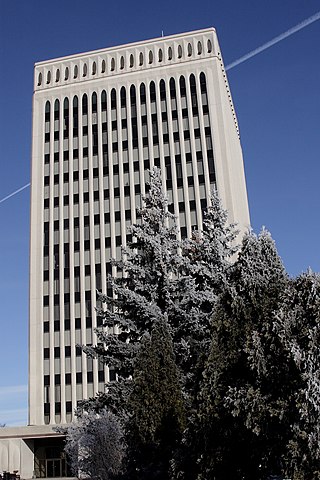
Queen Elizabeth II Court is the city block containing Regina City Hall, a 16-storey office tower in Regina, Saskatchewan, Canada. The city hall is built in the International Style.

Knox-Metropolitan United Church stands on Lorne Street at Victoria Avenue across from Victoria Park in downtown Regina, Saskatchewan, Canada. It is the current manifestation of Presbyterian and Methodist congregations that date back to "worship services in both traditions…in 1882."
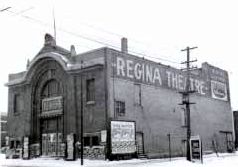
The old town hall, on the northeast corner of Scarth Street and 11th Avenue in Regina, Saskatchewan, was converted to the Bijou Theatre in 1908. Hand-cranked silent movies were shown with piano accompaniment. Local amateurs and travelling road shows performed on its rickety, sloping stage. When the Bijou was hauled away in 1909, the Whitmore brothers, A.E. (Bert), George and Dr. Frank, along with Chief Justice J.T. Brown and James Balfour, built the splendid new Regina Theatre which opened February 7, 1910. With 870 seats, including eight boxes, it was able to accommodate the largest travelling vaudeville shows and featured stage plays and concerts.

















